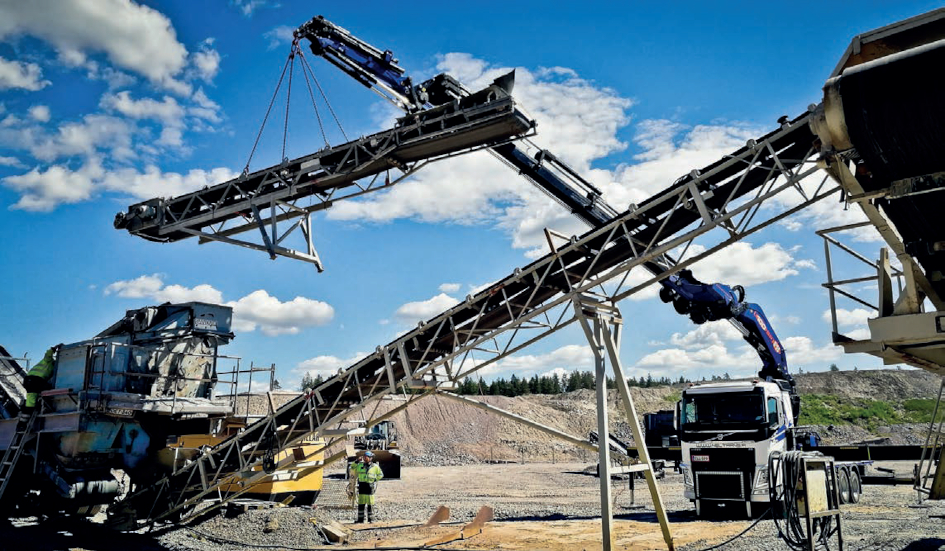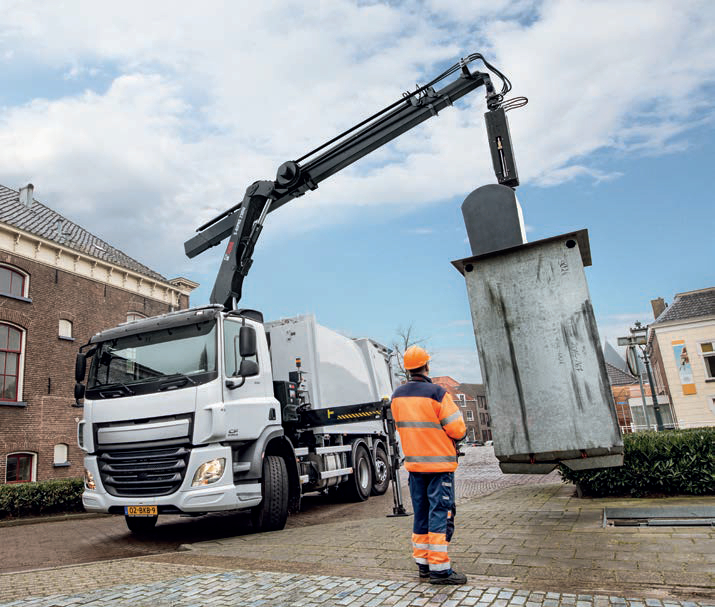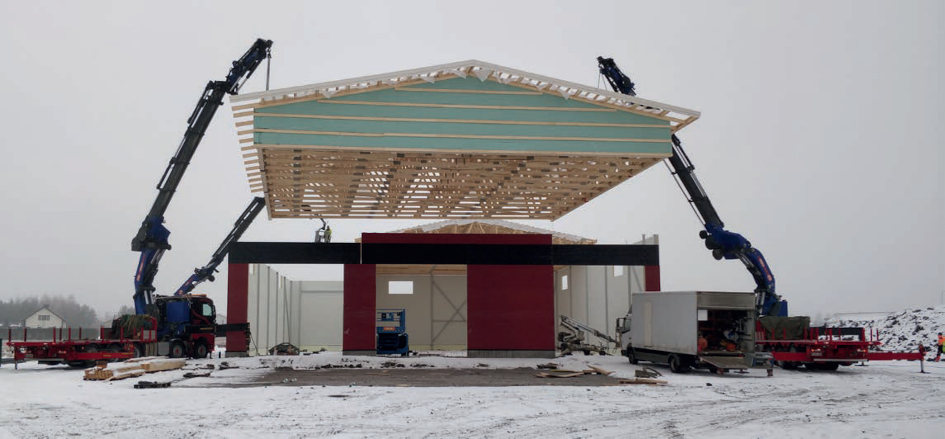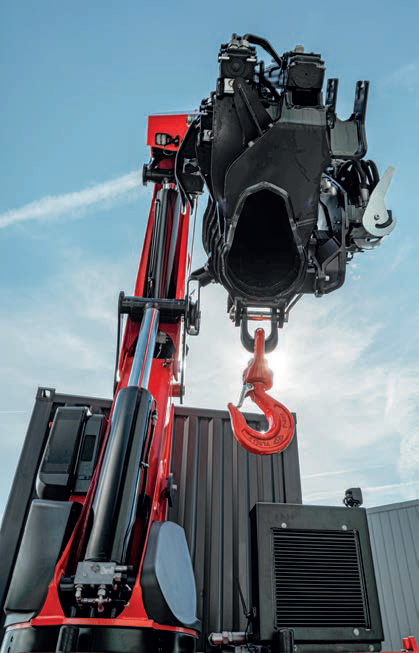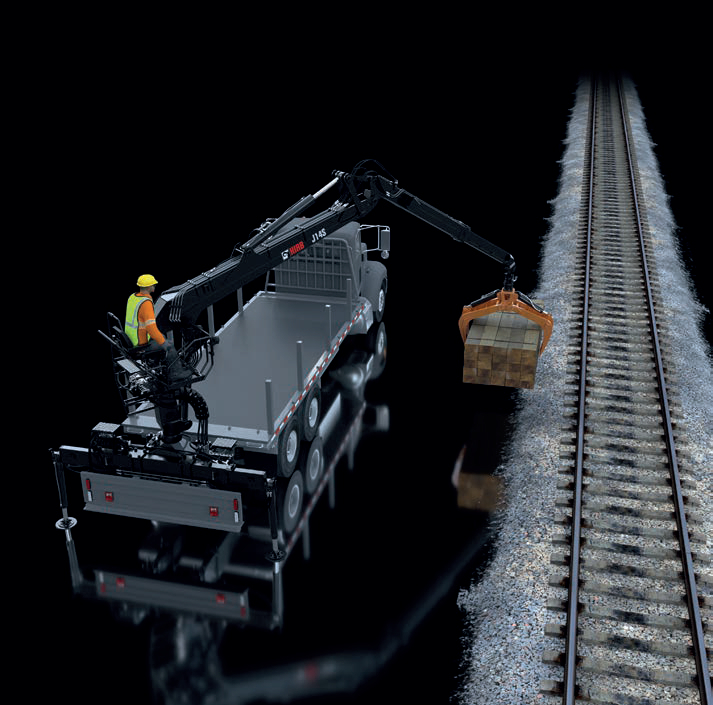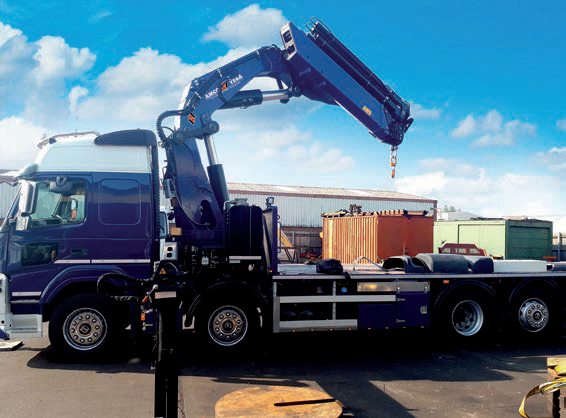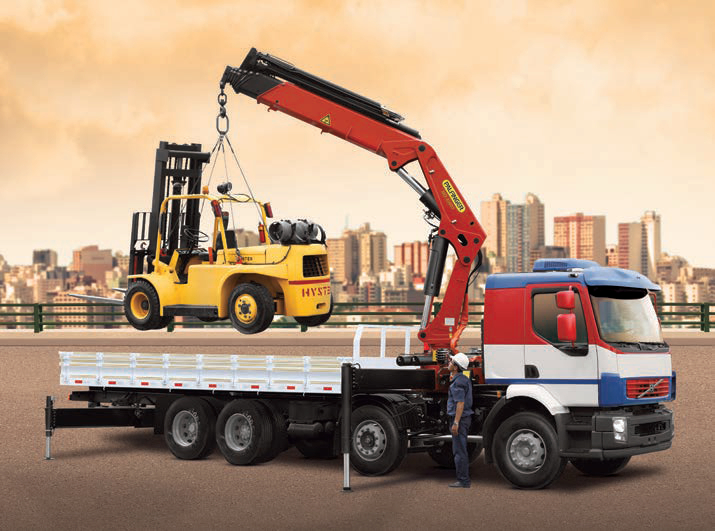Different places, different cranes
17 June 2021The knuckleboom crane is a standard product, the same around the world. Or is it? Julian Champkin finds local habits die hard, and the knuckleboom has many regional forms and favourites.
“Ever since humans built their first cranes to lift things in ancient Mesopotamia there have been different versions in different cultures and societies. There are different roads to go down to design your crane, so we find different crane concepts around the world. But they have one thing in common, for a very simple reason: they have in common the simple purpose of lifting stuff – sometimes small stuff, sometimes big stuff, sometimes high up, sometimes over long distances; but they are all about lifting goods.”
That is Stefan Oberleitner of Palfinger, their product line leader for loader cranes, wind and marine cranes, waxing philosophical about cranes in general and knuckleboom cranes in particular. One might suppose that the common knuckleboom, seen almost everywhere mounted either behind the cab of a truck or at the rear of its deck, is the same the world over. One would be wrong. The needs and cultural preferences differ around the world, causing manufacturers to offer different specifications and types of machines to different geographical markets.
Knucklebooms might be mainly about loading and unloading trucks; but there are different designs that will do that job, and culture and history—and simple chance, says Oberleitner —have played their part in which methods are preferred in which continents and countries.
Let us start with Europe. “That is the market that is driving and developing knucklebooms today,” he says. “It always has been, and it will stay in that leading position into the future. The highest demands for technology, for safety systems, for digital automation, for reach, they all come from Europe.
“Palfinger’s TEC range, for example, is our knuckleboom with the greatest focus on technology. Stand at the end of the boom of one and look up at it. See the way it is put together. What you see is engineering at its most dense.” Great thought and analysis have gone into every component, and into the way that they all function together. “The telescopic segments are a complex shape designed for maximum of efficiency in the minimum of space. It offers loads of functionalities; from an engineering perspective it has been put together in a challenging way. That complexity is the hallmark of a purely European design. It is not just the case with Palfinger cranes; it will be the same no matter which manufacturer you are considering.
“Palfinger has a global portfolio, and the TEC range is exported all over the world,” he says. “Even so, 95% of our TEC range models stay in Europe. It is our biggest crane, it has the longest reach, especially with a fly jib, it offers a variety of different things you can do with it; it is very flexible, it is designed for complex loading and unloading, perhaps very high up, through a door or through a window. This is what it is meant for.”
Palfinger has simpler ranges also. “One step below the TEC is our SLD range. ‘SLD’ stands for ‘Solid’; it is simpler, it is more robust, it doesn’t do very high or very heavy or very complicated lifting; what it does do well is loading and unloading things like bricks and blocks on and off the back of the vehicle itself, so it is what the average builders merchant wants and needs. And that of course calls for a different set of electronics, and less exacting specifications in reach and capacity, than the TEC, but it is more robust, more reliable, easier to use. Which is why it’s called ‘Solid’. Again the biggest market for this type of equipment is still Europe, but again it is exported, to Russia, to Asia and to America, and this time in quantity so this is more of a global product.”
Continents therefore have different demands; but even within Europe there are what he calls ‘local habits’: “There is a North- South divide. In Scandinavian countries you will find slightly bigger cranes, equipped with all the optional equipment you can get: the region is wealthy, so price is not such an issue. In the south, they buy the more basic versions.”
But Davide Catellani, cranes business director for Italy-based Amco Veba, part of the Hyva Group who also make Hyva and F.lli Ferrari knucklebooms, can point to an exception to that generalisation: Italy buys digital. All the extra safety and monitoring features that data connection and the internet of things can provide are demanded. “That is a highlight of the knucklebooms that we sell here,” he says. It is not because Italians love technology, although they do. “In Italy there is a tax break for owners and dealers who buy digitally-connected cranes. Our data connection systems can monitor how the crane is being used, give historical data and load and energy consumption details. The owner can see in real time how much it has lifted, when maintenance is due; the service people can identify potential failure, prepare proper assistance for repair ahead of need. So we started offering the connected crane for the Italian market so that the buyer could get the ‘Industry 4.0’ tax advantage: it was a boost to sell cranes with digital solutions. Now other European markets are buying them as well, but for their practical and safety benefits rather than for the tax break.”
“The historical reason for the use of specific equipment might not always be the optimal solution,” says Alexander Gelis, vice-president for sales and product management at Hiab and Effer. “Local rules and regulations may also push for some types of equipment to be used. In certain parts of the world, truck mounted forklift—the ones you see hooked onto the back of a truck by their forks, suspended over the roadway—are preferred as a means of unloading. In some other countries local rules prohibit their use, so a knuckleboom is used instead.”
“There is a big difference between the demands set by the EU compared with what we see in other markets,” he continues. “EU regulations put clear rules on the use of safety devices and controls, with a preference for remote controlled units.” End-of-hook systems also vary: “Applications and segments generally trigger the use of certain equipment. Two examples of specialised cranes in Europe are our Hiab S-HiPro 230W, which is specialised for collecting underground refuse containers, and the rail-specific Hiab X-Rail 192 loader crane that has recently been sold to Spain.”
Amco Veba has also recently experienced success in the rail market: “In 2019/20 we have had good performance in railway applications,” says Catellani. “It is a strange combination, different from the usual because they have specific requirements for mounting on a railway carriage rather than a truck. We adapted a couple of our models for that, selling to a company that is working specifically in that sector. For the moment that application is only in Europe.”
Giovanni Tacconi, general manager of PM Group cranes, agrees that Europe is where the high-tech is at. “A knuckleboom can be a very complex piece of equipment, or it can be quite simple. Europe takes the complex ones. The cranes that we specify for Europe come with very developed safety devices: it is the sophisticated end of the market.”
NORTH AMERICA
Tacconi says North America likes bigger capacity cranes than in Europe. “Europe prefers its knucklebooms compact, to fold up to fit into a small space on their medium-sized trucks. US truck dimensions are bigger, so compactness does not concern them.”
And again tradition and local history have their effect: “Straightboom truck cranes are very prevalent in the States: it is where they are developed. You don’t find too many of them elsewhere. But knucklebooms are getting more popular, even there. In fact, they are now outselling straightbooms. They are more expensive but they are becoming a popular product where they were little seen before.”
“In the US, Amco Veba has a niche in small cranes of 1 to 8tm mounted in a small vehicle such as a pickup or a trailer,” says Catellani. “The other popular capacity there is the 15 to 30tm range.”
At the other end of the capacity range but also for America, Amco Veba in February this year launched a knuckleboom which has what they say is the best lifting capacity in its segment, the 60tm VR60NG. Later in the year they will compliment it with a 40tm model. “These will span the high-capacity range; they are for a global market, but we expect particular interest from the US and Canada for the oil and gas industry.”
“The US has several application-focused sectors where knuckbooms play a key role,” says Gelis of Hiab and Effer. “One is the tree-care segment, where our Effer brand has a long history and strong market share. Another is the delivery of drywall for house-building; the Hiab drywall crane has been specially developed for that.”
Oberleitner of Palfinger finds the same US niche: “There, as in Europe, knuckleboom trucks are standard for housebuilders. They look very much like European knucklebooms,” he says, “but the truth is that they are used differently. Most houses there are made of ready-made drywall elements—prefabricated walls if you like—and the main purpose of the knuckleboom vehicle is to lift these elements, to the second or at most the third storey. This is a very specific application, one that you will only find in the US and Canada, and Palfinger has a specific range of models, the PW range, to serve it. It has a very long main boom, and generally four extensions to the telescopic boom, which together give the ideal geometry to reach a three-storey roofline. It has a simpler structure than our TEC range; there is nothing complex there; and the crane does not fold up behind the cab as a European knuckleboom would. Instead it allows itself a bit more space and stows in-line, over the truck deck and the cargo. It is not brutally engineered to the nth degree to save every inch. The focus is on reliability and doing the job, of a loader and deliverer to a set height. It is challenging work because it is doing lots of load cycles, so durability and reliability are necessary. The drywall knuckleboom is very much dedicated to its job, and there are a lot of those jobs around.”
“And there is another type of crane truck that is very specific to the US market, which is the service truck,” he says. “In Europe if you have a big bulldozer and it has a problem it will have a digital self-diagnosis system on board, so the mechanic will know what he will find when he gets to the machine and can load his truck accordingly. The truck need not be huge to carry what he needs. If the problem needs a crane to sort out you put the bulldozer on a flat-bed loader and take it to a service station. The US approach is different. It is a very big country, and the equipment they use, in mining, in utilities and the like, is even bigger than in Europe and is also clumsy and heavy and not very technological. Rather than bring the machine to a service station they bring the station to the machine. They use mobile service trucks to do the maintenance and repairs on-site. The truck is in effect a mobile workshop. It will carry many more parts since the machine it is repairing will not have on-board diagnostics; and of course, a proper workshop needs a crane.
“So the service trucks have cranes mounted on them. Typically it will be a stiff-boom crane – stiff-booms are technically less complex; but that is slowly changing and knucklebooms are making inroads into that market. But it is a market that you find only in the US and Canada.”
Another US application niche follows from the nature of their houses and from the climate: the Great Plains and Midwest are tornado country. “If it is a little windy it can blow half your house away,” he says. West of the Rockies, forest fires are another far-from-unknown disaster. “There is a role for post-disaster clearing-up and repairs, and there are knuckleboom vehicles designed for disaster recovery. Their geometry is close to that of forestry crane, and they are equipped with grabs. Many communities have these in their fleets.”
AROUND THE WORLD
Moving south, into Latin America, Brazil has its own design of knuckleboom. “Here Palfinger sells two different products, the PK range, which also sells elsewhere, but also our MD line, which is nothing else but a knuckleboom specific to that country. Unlike a European design it doesn’t fold up into a small window for travel. Instead it has an even shorter main boom than its European brothers, but the telescopic section is long and the whole thing parks in an upside-down U shape behind the cab. The end of the U hangs down below the chassis and the deck. On a European truck that would conflict with the exhaust or hydraulics; but the local VW trucks are simpler and it is permitted to modify them for the cranes in ways that in Europe are not allowed.
“It is just a different way of stowing the crane. It is a less complicated one, it’s also easier to use because the unfolding mechanism is not so complex; so someone clever in Brazil decided to do it, and the habit has stuck.
“When you are in Brazil you will find customers who prefer the PK style and customers who prefer the MD style; most prefer MD. It does the job, it is simpler, they know how to use it, it has always been there; it is just part of their culture.”
Brazil is not the only country to stick to its own traditions. Japan is another. “Knucklebooms are not seen at all in Japan,” says Tacconi of PM Group. “There they rely on straightbooms, a lot of them locally manufactured by Tadano. The reason I think is that Tadano simply got in there early, and so established the preference. At any rate selling a knuckleboom in Japan is almost impossible.”
And that, curiously, has affected the market in China. “There, Palfinger is in a joint venture with Sany,” says Oberleitner, “and the products we make for the Chinese market are branded Sany Palfinger. Here, historically, the Europeans first came in with knuckleboom cranes, then Korea and Japan exported straightbooms into China through the secondhand market; and both influences remain. But unlike in the US, the straightbooms in China are simple logistic units, used for loading and unloading the vehicle, not for construction. Congested construction needs complex cranes, so some knucklebooms, that can deliver through doorways and windows at some height, are used for that. The alternative is a tower. But stiff-booms are cheap to buy because the engineering is so simple, and are easy to operate; 80% of Chinese logistic cranes are stiff-booms, and that applies as well to most of Southeast Asia. Hong Kong, with its British connection, and Singapore, where space restrictions make lifting a complicated business needing high technology, are exceptions; there the knuckleboom is the norm.”
Sticking with Asia, “that is a very price-competitive market” says Catellani of Amco Veba. “But buyers there also demand a high level of quality, and especially of reliability, because in countries like Vietnam or Thailand they may be operating far from a service centre so the crane must be easy to service and maintain out in the field.
“So for that market the preference is for a crane that is very simple, and with as few electronics as possible. Electronics are hard to repair in a remote place. And this has been a reason for Amco Veba’s success there in recent years: we have cranes that are simple, which appeals to them, even if we also have other cranes of higher performance or capacity.”
Finally we come to Russia. “Here, Asia and Europe meet, and both influences are there” says Oberleitner of Palfinger. “You will find a market for knucklebooms as well as for straightboom cranes, and it is simply up to the client which one he personally prefers. It will depend on his typical applications, and the availability of space on his truck. If all the deck-space is wanted for cargo, you might go for a knuckleboom because it folds neatly out of the way. There is another curiosity here, though. If you have imported a chassis, say a Mercedes or MAN or Scania, it is very likely that you will put a knuckleboom on it; if you are using a local Russian-built truck you will probably mount a stiff-boom. It is a tendency rather than a rule, but you will hardly find a stiffboom crane on an imported European truck. It is just a bit of a mismatch. I suppose the theory is that if you are paying extra for a knuckleboom you might as well pay for a good truck as well.”
So we live in a small interconnected planet, but one still large enough to allow local niches and variations in even so universal a machine as a knuckleboom crane. Diversity is a wonderful thing. Long may it last.
